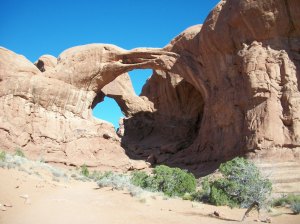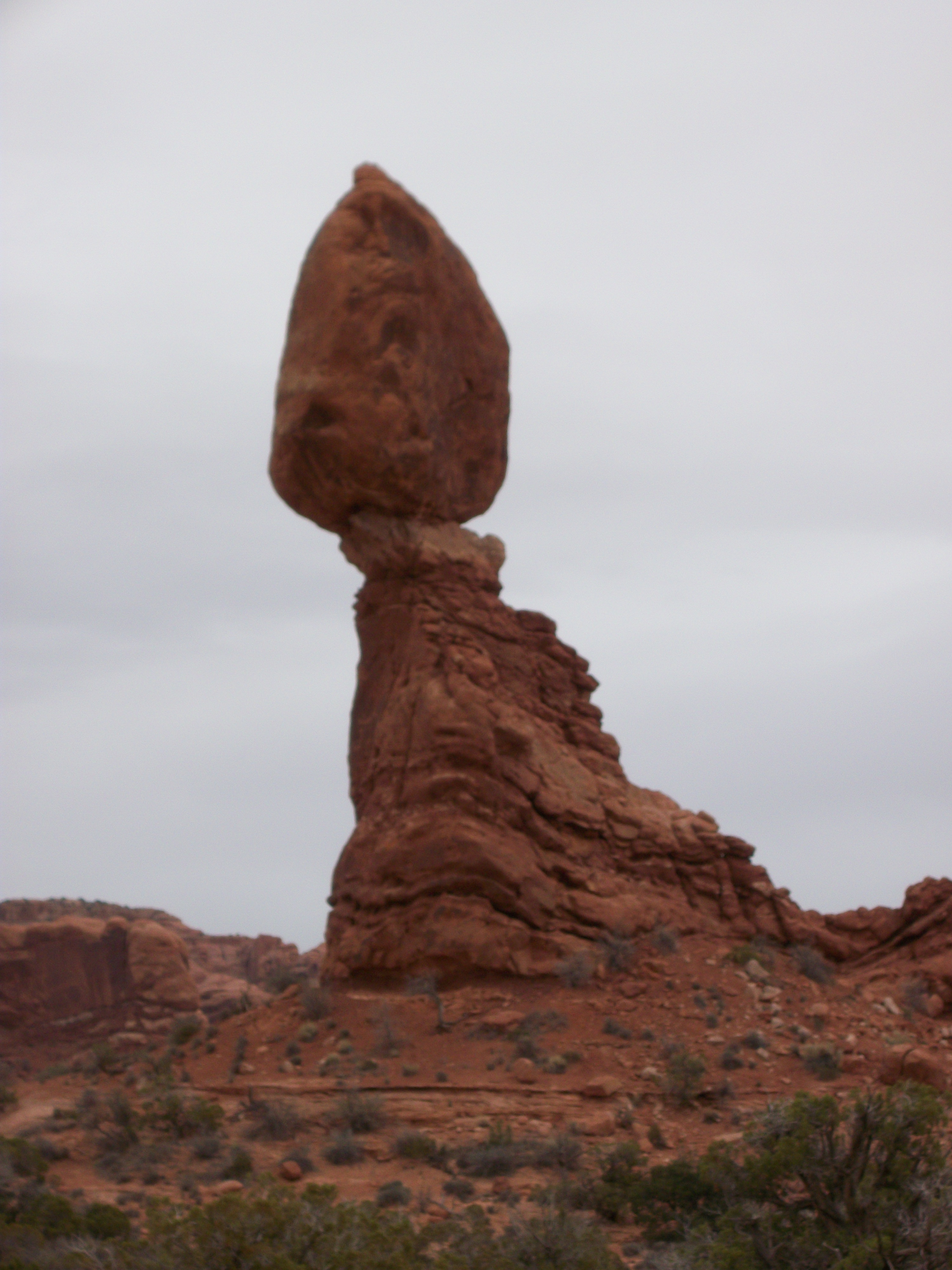 Over Spring Break our family visited two National Parks in Utah, Arches and Canyonlands. We stayed in the small town of Moab, where an interesting mix of ex-uranium miners and twenty-something mountain bike enthusiasts live tucked in between towering red rock mountains. Although the boys and Todd did enjoy some challenging mountain bike trails which Moab is famous for, mostly the kids wanted to explore the National Parks on foot.
Over Spring Break our family visited two National Parks in Utah, Arches and Canyonlands. We stayed in the small town of Moab, where an interesting mix of ex-uranium miners and twenty-something mountain bike enthusiasts live tucked in between towering red rock mountains. Although the boys and Todd did enjoy some challenging mountain bike trails which Moab is famous for, mostly the kids wanted to explore the National Parks on foot.
As we neared the entrance to Arches, with its wide-open desert spaces housing massive, and just plain weird-looking, sandstone structures sculpted by wind and water, the energy level in our car soared. The kids wanted to jump out and experience it all right then.
However, they knew our first stop would be the visitor’s center where we’d ask the park rangers about our hiking options. Once inside, I was even able to wrangle our group to watch a short film describing Arches. After this we asked a naturalist for trail recommendations. We wanted a hike where the kids could scamper around some of the area’s harder rock, called slickrock, and if possible be at lower risk for tumbling over a cliff.
With the info the ranger supplied us we set out for the trailhead, driving through a strange landscape that can best be described as martian-like. As when you lie on your back, watching the sky and superimposing known images onto passing clouds, the odd sandstone formations at Arches begged for labels. Near the Double Arch trail, for example, stood a Taj Mahal-like rock surrounded by melted icecream cone shapes. Soon after this we spotted a huge alligator rock with the hump of a camel. Rock naming definitely engaged the kids.
But by the end of our first day though, none of the trails the ranger recommended had allowed the kids to climb around. Instead she’d steered us to sand-filled trails which were more like walking at a beach (surrounded by arches).
On our second visit to Arches a few days later, we asked another ranger for advice. We also had a variety of geology questions which hadn’t been addressed in the film or the visitor’s center displays. Having spent a summer during college working at Alaska’s Glacier Bay National Park, I’d developed utmost respect for the knowledge rangers and naturalists possess. The naturalists I met up there were some of the most intelligent folks I’ve ever spent time with.
But this time the naturalist seemed a bit stumped by what I assumed were fairly basic geology questions. This led me to wonder whether I was seeing an effect of our dwindling funding for national parks. Little funding means little training for naturalists. Entrance to Arches costs a mere $10 per vehicle, and this price even covers a week of return trips. We later spent that much on hot chocolate in Moab. Money is tight for us as it is for many these days, but I for one would be willing to pay much more for National Park entrance fees.
On our last day, we decided to do one final hike at Arches. This one was described in our literature as strenuous, but would take us close to the frequently photographed Delicate Arch. Soon after we began walking, bundled in winter coats and hats, the trail led us to an old homesteading cabin built partially underground, most likely for protection from the wind which was indeed blowing strongly in our faces.
I’m always looking for ways to help my kids be grateful for their home and belongings. This one-room cabin quickly did the trick.
Next the trail took us to some old Ute Indian petroglyphs, seemingly describing a successful bighorn sheep hunt. Totally cool.
We continued on, up a hill and around a corner, and there it was — not Delicate Arch (we had an hour’s worth of hiking before we reached that) but the span of slickrock we’d been hoping for! The kids screamed with excitement and began to climb and explore. Our trail passed over a vast expanse of smooth, hard rock, which included deep gullies where storm water ran, and some vertical walls with ample footholds. I have no idea why this hike wasn’t recommended to us when we asked. Perhaps because it was fairly steep at times.
Daniel (10) has been in a Spiderman phase since we recently rented a DVD of 1970’s era Spiderman cartoons. Upon seeing this slickrock portion of the path, he immediately became Spiderman, scaling the five foot walls and striking numerous superhero “alert and ready” poses.
Stephen (12) also enjoyed some Spidermanesque climbing, and when he became weary of this, began pondering the surrounding geology.
Annie (7) was Spiderman for a short while, but slightly less hooked in because “I only sort of like Spiderman since he isn’t a girl.” (Please take note, Pixar. More female superheroes requested.)
Up, up, up, we followed the trail. Predictably Annie became tired first. After a rest and a snack she was re-energized, and thought back to the petroglyphs of mountain goats and sheep. “I’m a mountain goat!” she declared as she began scampering around once more.
As I watched her, something I’d recently read flashed through my mind. The book Nurture Shock, by Po Bronson and Ashley Merryman, has a chapter about a successful preschool program called Tools of the Mind. Two educational psychologists, Deborah Leong and Elena Bodrova, who happen to work at the same college Todd does, created a curriculum for preschool and kindergarten children based on the work of Russian psychologist Lev Vygotsky.
Tools of the Mind classrooms evidently don’t look much different from those of other schools, but their curriculum helps kids control their behavior and resist impulses, which research suggests is extremely important for learning.
When Annie was a mountain goat on our hike, it reminded me that in Nurture Shock, I’d read about a Russian study in which young kids were told to stand still for as long as they could, then timed. They lasted an average of two minutes. Next they were told to stand still as long as they could while pretending to be soldiers. This time they lasted an average of eleven minutes.
The Tools program uses a great deal of imaginative play, but it requires kids to make a plan for their play and holds them to it. The children take on a certain character or role for up to an hour in class. This exercise and others, such as noticing when you’ve made a mistake and self-correcting, have been found to significantly improve the executive functioning of children in the Tools program.
Executive function is generated in the all-important prefrontal cortex of the brain and includes skills such as, planning, organizing, strategizing, paying attention, remembering details, and managing time and space. Sounds good for parents too, doesn’t it?
Let’s just say that if my own executive functioning had been in full swing the day of our Delicate Arch hike, I might have followed the suggestions of the Tools curriculum more closely. Before we began hiking, I might have planned with each kid what they could “do” to help them tolerate an arduous hike.
I probably would have encouraged Daniel to be Spiderman when we came upon climbing areas, but then encouraged him to think of other things Spiderman could do along the hike. Knowing Daniel, I assume that in addition to climbing he would have been searching for Spiderman’s foes and discovering hiding spots.
Annie, on the other hand, might still have been a mountain goat, but I’m sure we could have taken this idea further. She likely would have decided to be a Mama mountain goat and then she could have played out some scenario in which she cared for her babies along the hike.
In the end, we did complete our hike with or without the full Tools of the Mind repertoire. It was a challenging and rewarding trek, and there were some drop-offs to be wary of at the trail’s end. But Todd and I were able to see the Delicate Arch up close, along side Spiderman, a mountain goat, and a budding geologist.
____
By the way, Canyonlands was lovely too, but I would recommend going on a day without a snowstorm and 50 mph winds.

 Sweet Spots: Helping Your Kids Find ENOUGH in Their Lives.
Sweet Spots: Helping Your Kids Find ENOUGH in Their Lives.


How funny–We took almost exactly the same vacation at the same time! We even took pictures of the same petroglyphs.
One neat side trip we took (actually several times in the same vacation–it was that interesting) was to the Linn Ottinger rock shop in Moab. It is a cross between a shop and a museum. The people working there were amazingly informed about rocks and fossils in the area, and told us of several spots were we could do our own rockhounding. Alas, it was cold and windy and that activity will have to be saved for another day. I did find the title of a great book for Colorado, though–Rockhounding in Colorado.
I have also been reading about executive skills, and have heard of that title–will order it from the library today.
Sounds like a great rock shop! We’ll have to remember this for next time. Thanks for the info.
I’m glad to see these suggestions of ways to help improve executive function. I’ve been wanting to do similar exercises with our daughter, to help her learn to wait and begin to improve her impulse control. I don’t have much faith that our big public school system in Los Angeles is going to incorporate such exercises in the near (or even long) term, so it’s great to have a reading suggestion on how to do it at home!
Your suggestions about using A child’s imagination to prolong his interest are wonderful. Those wonderful photos make me want to return to a fascinating national park. Too bad the rangers weren’t as knowledgeable as you expected.
I just finished Nuture Shock as well and am THRILLED to hear about the “tools of the mind” program. Only problem is – I have yet to find it offered in my area. I’m looking into purchasing the teacher text book and educating myself as much as possible on it and using it at home.
What a great idea!! I wish I had done that when my kids were younger. I’m sure yours will benefit.